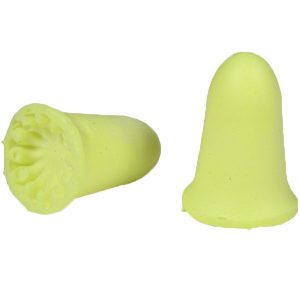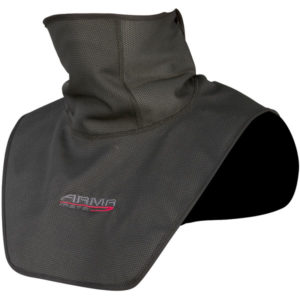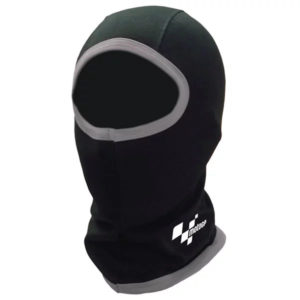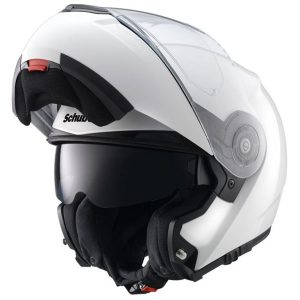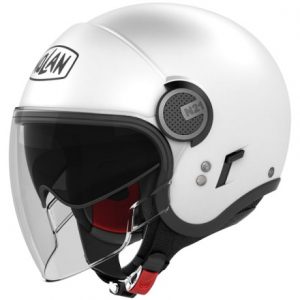I remember the first time I put a scarf on under my helmet.
I’d only been riding since the summer, and it was just starting to get chilly.
I tucked it up under my helmet to see how much warmer I’d feel, but my immediate thought was
Damn – this is much quieter
It wasn’t even a motorcycle specific scarf either – just something I’d found lying around the house.
Whether we’re making our living on a bike, putting in eight hour days on recreational tours or just taking our new CBR 1000RR out for three hours on the weekend – all that prolonged exposure to wind, road and engine noise does damage our hearing.
Luckily, there are ways to reduce this noise – many of them relatively cheap and simple.
Protect your hearing.
You only get one set of ears.
Save Money On Your Motorcycle Insurance
- You could pay less than £195*
- Compare quotes from 25+ UK providers
- Fill in one form to compare top bike insurers
What’s With All That Noise?
Riding is a loud business..
You’ve got the engine, road noise (the sound of your tyres on the road), and wind noise to contend with.
Typically, an engine will produce about 80 to 90db while idling and in excess of 100db when accelerating.
Wind noise is easily the most dangerous here.
The sound of air being displaced around your head at high speed in a full-face helmet can exceed 115db.
Earplugs
Makes sense, right?
Put stuff in your ears when things get loud.
Custom-fitted earplugs are fairly inexpensive these days and comfortable on long rides.
The one-size-fits-all options have come a long way and are very similar to musician’s earplugs in design.
They aim to isolate harmful frequencies using the size of the aperture in the plug.
This means you can still hear what’s going on around you, but you’re protected from the harmful stuff.
We did a deep dive on this topic, take a look if you are after the best motorcycle ear plugs.
Windbreaker
The Windjammer accessory is a unique take on wind noise reduction.
It’s a neoprene skirt attached to the bottom of your helmet on the outside.
When installed you’re left with a small, but stretchy hole to pop your head through.
This makes a clean seal around your neck resulting in reduced airflow hitting the bottom of your helmet – and therefore less noise.
It works and can also be taken on and off as needed. The manufacturers say the adhesive will continue to work even after washing.
Balaclava/Scarf
Balaclava’s and scarfs are a cheap and surprisingly effective option. This one is less than a tenner from SportsBikeShop.
Anything that decreases the amount of wind entering your helmet from the bottom will reduce noise.
Generally speaking, your balaclava should feel tight at first and stretch to fit your face.
The intention here is to seal up air gaps for the purposes of temperature and noise insulation.
Balaclavas that roll down below the collar line of your jacket will keep you warmer and the volume lower.
A scarf wrapped around your neck and tucked tightly up into your helmet will create a significant reduction in noise.
Pair this with a balaclava and things will quieten down significantly.
Earmuffs
Motorcycle ear muffs with noise-cancelling/music options are also an after-market option.
These differ from the helmet speakers designed to fit in the cut-outs present in many helmets.
Earmuffs form a seal around the ear helping to reduce noise.
If your helmet is already noisy, adding speakers won’t help. Unless they form a seal around your ears you will have to turn up the volume to dangerous levels to cancel out the existing noise.
The problem here is that these muffs are typically between 35-45mm thick and won’t fit under your helmet unless you remove some padding.
Choose A Good Helmet
We’ve gone deeper into this in the article below.
In summary, because they are put on in the ‘up’ position – modular helmets have a smaller opening in contact with the wind.
This results in less noise.
Snug Fit
If there is space inside your helmet, that space will fill with swirling air once you start moving.
This is noisy – not good.
Pay attention to the cheek pads.
If they fit snugly they can help dampen vibration coming up from the bottom of the helmet, and reduce vibration when the visor is open.
The neck roll should also feel snug. The closer the fit is here – the less space there is for air to travel up into the space and create noise.
Windscreen
Though your windscreen is designed to drive airflow away from your head, there are some combinations of screen, helmet and rider height that can result in increased wind noise.
The idea here is to have the windscreen drive air flow up and over the rider’s head.
If this isn’t happening in the stock position, you can try raising the height of the windshield.
For the exceptionally tall among us a windshield spoiler might be useful.
There are a number of these on the market, but all attach to your existing screen to increase its height.
Well-Fitting Visor
Vibration is the source of noise inside our helmets, so moving components are the most likely culprit.
For this reason it’s always worth looking at the vents and visor.
A poorly sealed or loose visor will create a lot of noise. Low quality vents will loosen over time and begin to rattle in the wind.
It might sound obvious, but riding with your visor open will create a lot more noise.
You’ll feel your visor click slightly as it reaches the fully-closed position – this is the point where it is at its quietest.
A well-designed helmet should still be fairly quiet with the vents in the open position.
Riding Position
Your riding position will have a dramatic impact on how much airflow is hitting the bottom of your helmet.
On a sports bike the opening of the helmet is facing away from the direction of the airflow and therefore quieter.
Touring bikes use larger windshields to drive the airflow up and over the rider’s head.
Street and naked style bikes have a more upright riding position and expose the opening to more airflow.
Luckily, due to their limited fairing these styles of bike tend to create very low levels of wind noise themselves.
The lack of spoilers, screens and fairing also means there aren’t any unintentional air flows striking your helmet.
Conclusion
So there you have it, 9 ways to make your motorcycle helmet quieter, some simple and cheap, others requiring more effort. Let us know if you have any other tips!
Recommended Reading: Motorcycle gear hub
Image Credits
All product images via SportsbikeShop


